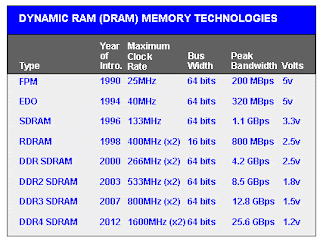What is the difference between a 32-bit and 64-bit CPU?

The two main categories of processors are 32-bit and 64-bit. The type of processor a computer has not only affects its overall performance, but it can also dictate what type of software it uses.
32-bit processor
The 32-bit processor was the primary processor used in all computers until the early 1990s. Intel Pentium processors and early AMD processors were 32-bit, which means the operating system and software work with data units that are 32 bits wide. Windows 95, 98, and XP are all 32-bit operating systems.
64-bit processor
The 64-bit computer originated in 1961 when IBM created the IBM 7030 Stretch supercomputer. However, it was not put into use in home computers until the early 2000s. Microsoft released a 64-bit version of Windows XP to be used on computers with a 64-bit processor. Windows Vista, Windows 7, and Windows 8 also come in 64-bit versions.
Another big difference between 32-bit processors and 64-bit processors is the maximum amount of memory (RAM) that is supported. 32-bit computers support a maximum of 4 GB (232 bytes) of memory, whereas 64-bit CPUs can address a theoretical maximum of 18 EB (264 bytes). However, the practical limit of 64-bit CPUs (as of 2018) is 8 TB of addressable RAM.
Differences between a 32-bit and 64-bit CPU
A big difference between 32-bit processors and 64-bit processors is the number of calculations per second they can perform, which affects the speed at which they can complete tasks. 64-bit processors come in dual-core, quad-core, six-core, and eight-core versions for home computing. Multiple cores allow for an increased number of calculations per second that can be performed, which increases the processing power and helps make a computer run faster. Software programs that require many calculations to function smoothly can operate faster and more efficiently on the multi-core 64-bit processors, for the most part.
Another big difference between 32-bit processors and 64-bit processors is the maximum amount of memory (RAM) that is supported. 32-bit computers support a maximum of 4 GB (232 bytes) of memory, whereas 64-bit CPUs can address a theoretical maximum of 18 EB (264 bytes). However, the practical limit of 64-bit CPUs (as of 2018) is 8 TB of addressable RAM.
High amounts of RAM are especially useful for software used in graphic design, engineering, and video editing as these programs have to perform many calculations to render their images.
One thing to note is that 3D graphics programs and games do not benefit much, if at all unless the program is 64-bit. A 32-bit processor is adequate for any program written for a 32-bit processor. In the case of computer games, if it's designed for 32-bit processors, you'll get a lot more performance by upgrading the video card instead of getting a 64-bit processor. However, if the game is designed for 64-bit processors, upgrading to a 64-bit processor will make a big improvement in the performance of the game.
In the end, 64-bit processors are commonplace in home computers today. Most manufacturers build computers with 64-bit processors due to cheaper prices and because more users are now using 64-bit operating systems and programs. Computer parts retailers are offering fewer and fewer 32-bit processors and soon may not offer any at all.
Applications all use shared resources on a Windows system (called DLL files), which are structured differently depending on whether it’s used for 64-bit applications or 32-bit applications. If, for instance, a 32-bit application reaches out for a DLL and finds a 64-bit version, it’s just going to stop working. That’s the problem.
32-bit (x86) architecture has been around for a very long time, and there are still a host of applications that utilize 32-bit architecture — though that’s changing on some platforms. Modern 64-bit systems can run 32-bit and 64-bit software because of a very simple and easy solution: Two separate Program Files directories. When 32-bit applications are sequestered to the appropriate x86 folder, Windows knows to serve up the right DLL — the 32-bit version. Everything in the regular Program Files directory, on the other hand, can access the other content.
The same, but different
The best example of this difference is right within your file system. If you’re a Windows user, you’ve probably noticed that you have two Program Files folders: One labeled simply Program Files and the other labeled Program Files (x86).Applications all use shared resources on a Windows system (called DLL files), which are structured differently depending on whether it’s used for 64-bit applications or 32-bit applications. If, for instance, a 32-bit application reaches out for a DLL and finds a 64-bit version, it’s just going to stop working. That’s the problem.
32-bit (x86) architecture has been around for a very long time, and there are still a host of applications that utilize 32-bit architecture — though that’s changing on some platforms. Modern 64-bit systems can run 32-bit and 64-bit software because of a very simple and easy solution: Two separate Program Files directories. When 32-bit applications are sequestered to the appropriate x86 folder, Windows knows to serve up the right DLL — the 32-bit version. Everything in the regular Program Files directory, on the other hand, can access the other content.










